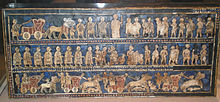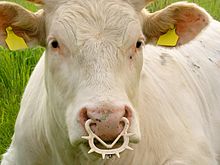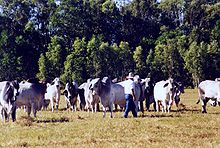- Nose ring (animal)
-
For nose rings as jewelry, see nose piercing.
A nose ring is a ring made of metal designed to be installed through the nasal septum of domestic cattle, usually bulls. Nose rings are often required for bulls when exhibited at agricultural shows. There also is a clip-on ring design used for controlling other cattle for showing or handling. Nose rings are also used to prevent pigs rooting, and to encourage the weaning of young calves and other livestock by discouraging them from suckling.
Contents
History and purpose
Historically, the use of nose rings for controlling animals dates to the dawn of recorded civilization. They were used in ancient Sumer and are seen on the Standard of Ur, where they were used on both draught cattle and equines.[1]
It is estimated that 42% of all livestock-related fatalities are a result of bull attacks, and only about one in twenty victims of a bull attack survives.[2] Dairy breed bulls are particularly dangerous and unpredictable; the hazards of bull handling are a significant cause of injury and death for dairy farmers in some parts of the United States.[3][4][5]
Use
The nose ring assists the handler to control a dangerous animal with minimal risk of injury or disruption by exerting stress on one of the most sensitive parts of the animal, the nose. Bulls, especially, are powerful and sometimes unpredictable animals which, if uncontrolled, can kill or severely injure a human handler.[6][7]
Control of the bull may be done by holding the ring by hand, looping a piece of rope through it, clipping on a lead rope, or clipping on a stiff bull pole (bull staff). A rope or chain from the ring may be attached to a bull's horns or to a head-collar for additional control.
With an aggressive bull, a short length of chain or rope may be left hanging loose from the ring, so when he ducks in a threatening manner, the bull will step on the chain and be deterred from attacking.[8] This lead may also facilitate capture and control of a frisky bull.[9]
Construction and insertion
Bull rings are usually about 3 to 5 inches (8 to 13 cm) in diameter, depending on the size of the bull. Bull rings are commonly made from aluminum, stainless steel or copper, in the form of a pair of hinged semicircles, held closed by a small brass bolt whose head is broken off during installation. If a ring needs to be removed (for example, if the bull has grown out of it), it is cut or unscrewed.
The ring is normally placed on the bull between 9 to 12 months of age.[10] It is usually done by a veterinarian, who pierces the septum with a scalpel or punch. Self-piercing rings (with sharp ends designed to be pressed through the septum and then pulled together with a screw) have been available for many years; these are also usually installed by a veterinarian rather than the farmer.[11][12]
Other designs
Calf-weaning ring
Calf-weaning nose rings or nosebands provide an alternative to separating calves from their mothers during the weaning period. They have plastic spikes which are uncomfortable for the cow, causing her to reject the calf's efforts at suckling. Weaning nose rings are also available for sheep and goats. These nose rings (usually made of plastic) clip onto the nose without piercing it, and are reusable.
Bulldogs
Self-locking or spring-closing show-lead nose rings, also called "bulldogs" or nose grips, are removable rings that do not require the nose to be pierced. They are often used on steers and cows, along with a halter, at agricultural shows, or when handling cattle for examination, marking or treatment. They stay shut until released, and usually have a loop for the attachment of a cord or lead rope. They give similar control to a bull ring without the need for permanent installation.
Bull tongs
Bull-holders, also known as bull-tongs, have a pliers action and are used for short periods on grown cattle when they are being mouthed or drenched. A chain, rope or strap keeps the grips closed and may be passed over a bar at the front of a head bail to elevate the head. The thumb and forefinger may also used in this way on smaller animals.
Pig rings
Pigs dig or "root" with their snouts, and such digging may be undesirable in some circumstances. Nose rings make digging uncomfortable for the animal, although a rung pig is still able to forage freely through leaf litter and surface vegetation. Pig ringing may sometimes be required by local regulations, as when pigs are turned out for pannage in public woods (such as on the New Forest in southern England).
Pig rings usually consist of open copper wire rings with sharp ends, about one inch (about 2.5 cm) in diameter. These are clipped to the rim of the nose, not through the nostrils. Typically an adult pig will be given three or four rings, as they may sometimes be dislodged. Alternatively a ring may be placed through the septum, similar to a bull's ring.
Bull handling in the show ring
For safety reasons, many show societies require bulls over 12 months to be led with a nose ring. A bull may be led by a rope tied through the ring, although a halter (headcollar) is usually also used so as not to rely unduly on the nose ring for control. If the bull has horns, the lead rope may also be fastened around those and then passed down through the nose ring. Some shows require other cattle to be led with nose grips (bulldogs). Several methods exist for handling a bull with a ring installed. One method of leading a bull is to have one person either side of the bull with both halter lead ropes through the ring, which prevents the bull from gaining pace and also from running into the handlers.[13] Another practice is for one handler to use a rope and the other a bull-staff attached to the ring.[14][15]
Bull handling on the farm or ranch
Most cattle breeders recognize the importance of looking after expensive bulls that are expected to improve herds and profits. Nonetheless, the dangers of bull handling, particularly from dairy bulls in close quarters, are regularly proven by the obituaries.[16] Good bull management and safety practices require caution in handling beef and dairy bulls, and use of the nose ring and chain is a recommended precaution for modern farmers.[17][18]
However, in many regions, particularly in the beef industry, bulls do not have nose rings unless they are to be exhibited and they are generally driven about as other cattle would be.[19] Cows with young calves can be particularly dangerous if protecting their young, and cattle in general, including calves, steers and bullocks, do cause many serious human injuries and deaths.[20][21][22]
Generally the use of both a ring and a halter, and management of the bull by two people, is the preferred method today for controlling the bull. Typically, a bull was led by a wooden staff with a steel end that snapped into the ring.[23] A long rigid steel or wooden bull staff locked into the ring could also be used to push a bull out of a pen without requiring the handler to enter the pen for cleaning or feeding.[24] Because of the risk that the bull may drive the staff into the handler if the bull misbehaves[25] many handlers prefer to avoid their use nowadays. One current veterinary text still recommends the use of a staff in addition to the halter:
Many handlers rely on a nose ring to control a bull. But a ring in his nose is no good unless you have a bull staff and use it. A bull staff is a pole with a snap in the end that clips to the bull ring. Leading a bull with a staff gives you a lot more handling power as the bull can't get any closer to you than the length of the staff allows. Leading him only by a chain in the ring lets him run over you at will.[26]
Most dairy or beef farms traditionally had at least one, if not several, bulls for breeding purposes.[27][28] The handling of an aggressive, powerful animal was a practical issue with life-threatening consequences for the farmer.[6] The need to move the bull in and out of its pen to cover cows exposed the farmer to serious jeopardy of life and limb.[29] Being trampled, jammed against a wall or gored by a bull was one of the most frequent causes of death in the dairy industry prior to 1940.[30] As suggested in one popular farming magazine, "Handle [the bull] with a staff and take no chances. The gentle bull, not the vicious one, most often kills or maims his keeper." [31]
When allowed outside its pen, the bull typically was kept in a halter connected by a strap snapped into the ring in his nose for ease of control.[32] In the bull pen, the use of a ring connected by a cable to a fixed point was recommended as a means of controlling and securing the bull while allowing a degree of movement by the subject bull.[33] If the pen was strong enough, the bull could be turned loose, and if needed, placed in a stanchion.[34] Farmers who lacked an assistant, or a bull staff, had no choice but to adopt other means. Some farmers elected to move their bulls by tying a rope to the ring and tying the other end of the rope to a farm tractor, providing both motive power and a degree of protection from the angry bull.[35] The efficacy of this technique is doubtful, and may depend on the size of the tractor and of the bull; one authority has "seen a bull lift the front end of a tractor like a toy".[26] Others used dogs and horses. Not all farmers could afford specially designed and manufactured bull handling products, which were not readily available until the 1980s. The experimental improvisation of techniques for bull handling, as in many aspects of family farming, was a common practice.[36][37]
See also
References
- ^ Calvin W. Schwabe, 'Cattle, Priests and Medicine', Vol.4, at p. 16 (U. of Minn. 1978), ISBN 0-8166-0825-3
- ^ Canadian Farming Administration, Handling Livestock Successfully, 2000
- ^ Larry D. Jacobson, Extension Agricultural Engineer, Safe Work Practices on Dairy Farms, University of Minnesota Extension Services (1989)("During the last 10 years, 12 farmers in Minnesota were mauled and gored to death by dairy bulls").
- ^ Cumberland County (Pa.) Sentinel, Shippensburg, Pa., February 12, 2008 A farmer in Southampton County, Michigan, was killed by a 2000 pound Holstein bull in Cumberland County, Pennsylvania, in February, 2008, prompting comments from experts ranging from "never trust a bull" to "always take a dog with you" when handling a bull.
- ^ The Reading (Pennsylvania]Eagle), March 1, 2010 On February 28, 2010, a farmer near Reading, Pennsylvania was trampled and gored to death by a 2000 lb. black Angus bull that he had been urged to get rid of by friends after earlier mishaps. Michelle Park, "Bull attacks, kills owner at South Heidelberg Township farm".
- ^ a b Jack Albright, Why and how to read a cow or bull, Hoard's Dairyman Magazine, W.D. Hoard and Sons Co., Fort Atkinson, Wis., (Nov. 2000)
- ^ Dairy Care Practices: Animal Care Series, Dairy Workgroup University of California Cooperative Extension (2008)
- ^ Miller, William C., & Robertson, Major E D S, Practical Animal Husbandry Oliver and Boyd, Edinburgh, 7th ed, 1959: p 16
- ^ Thomas J. Divers, Simon Francis Peek, Rebhun's diseases of dairy cattle, http://books.google.co.uk/books?id=PbEWJrEtECIC&pg=PA35
- ^ Dairy Care Practices: Animal Care Series, Dairy Workgroup University of California Cooperative Extension
- ^ C. Dalton, Noseringing a Bull
- ^ Dairy Care Practices: Animal Care Series, Dairy Workgroup University of California Cooperative Extension (2008)
- ^ Land Newspaper, Rural Press, Richmond, 20 March 2008 - p. 68
- ^ Bucks County Agricultural Health and Safety Policy
- ^ Bridgend County Show Health and Safety Policy
- ^ See C. Parsons, Students Mourn Teacher: FFA Advisor Killed by Bull, 81 Capital Press, No.38, page 1 (Sept. 19, 2008) (veteran agricultural instructor killed by a dairy bull after warning others not to enter pen)
- ^ Kerri Ebert and Michael Dennis, Pa. Ag. Extension Service, Cattle Safety, National Ag Safety Database, 2001
- ^ B. Grove & A. Mills, Bulls on the Dairy Farm, Kansas State University, Oct. 4, 2002
- ^ W A Beattie, Beef Cattle Breeding and Management, Popular Books, 1990
- ^ http://www.cfa-fca.ca/upload/casw_livestock.pdf
- ^ Serious Cattle-lnflicted Injuries
- ^ injuries are caused by a steer or cow
- ^ An example of a bull staff
- ^ The James Way, The James Manufacturing Co., Ft. Atkinson, Wisc. (1914), at p. 103
- ^ V G Cole, Beef Production Guide, Livestock & Grain Producers Association of NSW, 1978
- ^ a b C.E. Spaulding, D.V.M. & Jackie Clay, Veterinary Guide for Animal Owners, Rodale Press, Inc., Emmaus, Pa. (2d ed. 1998), p. 27.
- ^ U.S. Dept. of Agriculture, Yearbook 1922, Government Printing Office, Washington D.C. (1922), pp. 325-28 (noting a national on-farm bull population of over 600,000 "scrub" bulls in addition to a multi-year supply of "pure bred" bulls)
- ^ O.C. Gregg, Ed., Minnesota Farmer's Institute Annual No. 15, Pioneer Press, St. Paul, Minn. (1902), pp.129-32 (recommending the keeping and testing of sires for dairy herd improvement).
- ^ Alvin H. Clement, We Gotta Have More Jails, The Writer's Club Press, New York (1984-87), at pp. 79-80. A humorous description of moving a cow to a neighbor's Jersey bull for breeding purposes, and the use of a 12-foot bull staff to get the loose-running bull under control after he had already spotted the cow
- ^ O.C. Gregg, Ed., Minnesota Farmer's Institute Annual No. 15, Pioneer Press, St. Paul, Minn. (1902), at p. 125; The James Way, The James Manufacturing Co., Ft. Atkinson, Wisc. (1914), p. 103
- ^ Helpful Information for Dairymen, The Farmer Webb Publishing Co., St. Paul, Minnesota, Mar. 12, 1927, p. 6
- ^ O.C. Gregg, Ed., Minnesota Farmer's Institute Annual 15, p. 126, Pioneer Press, St. Paul, Minn. (1902)
- ^ The James Way, The James Manufacturing Co., Ft. Atkinson, Wisc. (1930), p. 114
- ^ The James Way, The James Manufacturing Co., Ft. Atkinson, Wisc. (1914), p. 103
- ^ Sara De Luca, Dancing the Cows Home: A Wisconsin Girlhood, Minn. Hist. Soc. Press, St. Paul, Minn. (1996) pp.99-100 (moving a heifer with a tractor)
- ^ M. Cotter & B. Jackson, Voices of America: Growing Up on a Minnesota Farm, Arcadia Publishing Co., Chicago, Ill. (2001), pp. 23-24 (driving a 1500 pound Hereford bull named "Domino" by repeatedly firing a shotgun loaded with birdshot into its rear end)
- ^ C.E. Spaulding, D.V.M. & Jackie Clay, Veterinary Guide for Animal Owners, Rodale Press, Inc., Emmaus, Pa. (2d ed. 1998), p. 27 (bull got a man down, knelt on him, and "ignored pitchforks stuck into him in an effort to get him away from the victim").
External links
Categories:- Animal equipment
- Livestock
Wikimedia Foundation. 2010.






